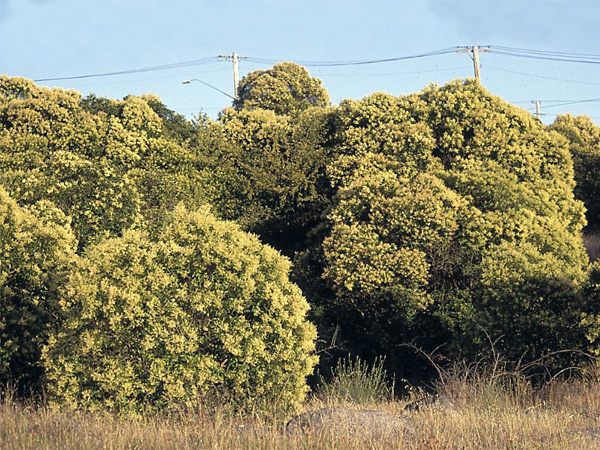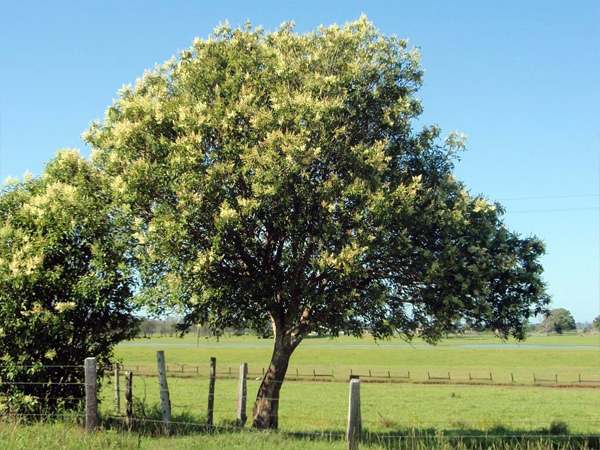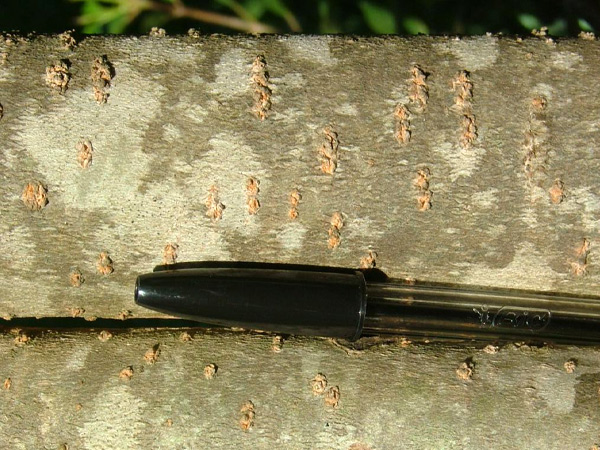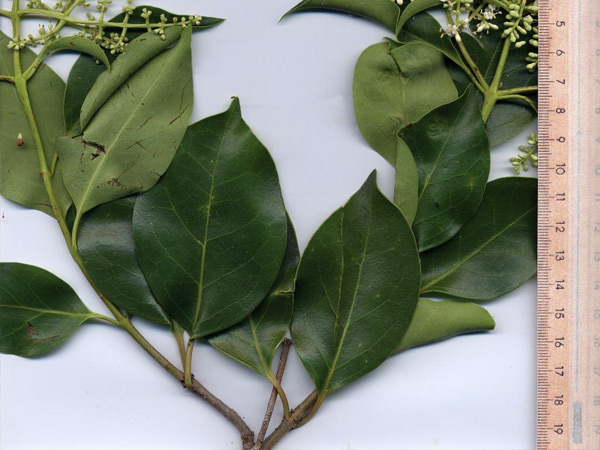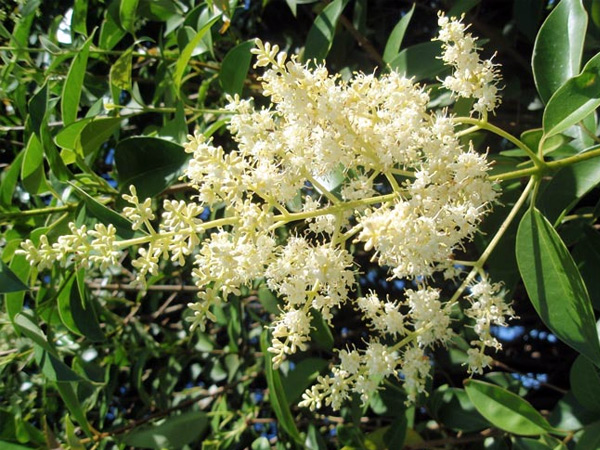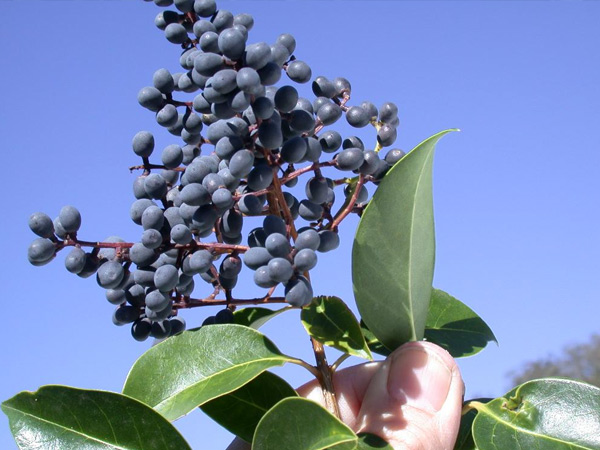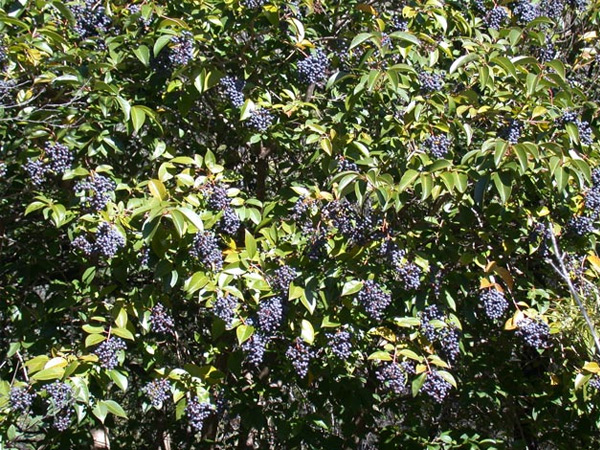Weeds
Privet broad-leaf — Ligustrum lucidum
Broad-leaf privet is an evergreen shrub. Used in gardens, it now has extensive environmental, agricultural and human health impacts.
Profile
How does this weed affect you?
Privets are considered to be serious environmental weeds throughout Australia. Infestations threaten biodiversity, including endangered plant and animal species and ecological communities. Dense stands of privet prevent other vegetation surviving or establishing. Broad-leaf privet invades ecosystems including subtropical and coastal rainforests, rainforest margins, warm-temperate and dry rainforest, wet and dry eucalypt forests, grassy woodlands, grasslands and riparian vegetation.
It is reported that privet pollen causes allergic reactions and hay fever. It is unlikely that the pollen of privet is strongly allergenic; however, cross-reactivity can occur where people who are sensitive to grass pollen can become sensitive to privet, producing allergic reactions. It is thought that the perfume of privet flowers causes these reactions, not the pollen. Reactions occur commonly during spring and early summer when privets produce masses of flowers and pollen. These include allergy-like symptoms such as asthma and irritation of mucous membranes. In one extreme case, hospitalisation resulting in near death occurred after the patient was exposed to privet.
Privet berries and leaves have been reported by overseas sources to be mildly toxic to humans and livestock if ingested in large amounts; however, no known cases of poisoning have occurred in Australia.
Privets invade native and plantation forest industries, orchards and pastures in Australia. Costs of control are high and yields are reduced by the presence of privet in these production systems.
Where is it found?
Broad-leaf privet originates from eastern Asia. It occurs as a widespread weed in coastal and tableland areas of New South Wales.
How does it spread?
Privet seeds are commonly spread by fruit-eating birds. Birds such as pied currawongs, silver-eyes and rosellas can spread the seed widely into previously uninfested areas. Privet seedlings often germinate in clusters, as a result of birds regurgitating the seeds. Birds and rabbits assist germination by removal of the soft coating around the seed.
Privets are also spread through the sale of garden plants from nurseries and markets, the dumping of garden waste containing seeds and the sale of foliage in floral arrangements containing fruit and seeds. Seeds can also be spread in flowing water.
What does it look like?
Broad-leaf privet grows as an evergreen shrub or small tree to a height of 4–10 m. The brown bark is covered in small white lenticels (pores that allow gas exchange).
Pointed oval-shaped leaves occur in opposite pairs, and are 4–13 cm long and 3–6 cm wide. The upper leaf surface is dark green and glossy or shiny while the under-surface is paler with distinct veins. Leaves are hairless.
Cream or white tubular flowers with four petal-like lobes occur in branched clusters – each flower is 3.5–6.0 mm long. Flowers have a sickly sweet fragrance.
Berries are 9 mm long and 12 mm in diameter, and are green when young, turning red through to blue to glossy or purplish black as they ripen. Berries usually contain two oval-shaped ribbed seeds 5 mm long. Roots are woody, branching, thickened at the crown and mostly shallow.
What type of environment does it grow in?
Broad-leaf privets prefer warm, humid environments with moderate to high soil moisture throughout the year. Creeks, gullies and drainage lines are favoured by both species, but seedlings are able to establish in drier areas if run-off water is temporarily available. Both species occur in areas with rainfall between 700–1600 mm. Its seedlings can tolerate very low light levels, allowing them to persist beneath dense canopies of vegetation.
Privets have been found growing in a range of soil types, from pure sands through to friable loams, and almost pure clays. However, it is generally agreed that privets thrive on more fertile shale or clay-derived soils found in riparian areas.
Acknowledgements
Authors: Elissa van Oosterhout, J. Mowatt, Leon Smith, Stephen Johnson.
Technical reviewers: Stephen Johnson, Birgitte Verbeek.
References
Hardin, D. (1992), Ligustrum vulgare L. New South Wales Flora Online, Royal Botanic Gardens and Domain Trust, Sydney.
Johnson, S. (2009), Review of the declaration of Ligustrum (privet) species in NSW, NSW Department of Primary Industries, Orange.
Johnson, S. B. (2009), ‘Privet species – are we sitting on species time bombs?’, in Proceedings of the 15th Biennial NSW Weeds Conference, Narrabri, NSW Department of Primary Industries, Orange.
Control
The following are guiding principles for privet control and management.
- Locate, map and monitor the extent of an infestation and any changes in weediness, as well as any cultivated plants in the locality of the infestation.
- Identify key sites, assets or industries at risk from the infestation (natural ecosystems, human health, primary production, etc.).
- Control infestations in close proximity to the identified key sites/assets/industries, aiming to reduce weed density.
- Prevent spread from cultivated plants in the locality.
- Continue to control growth and spread of the infestation.
Controlling spread
Wide dispersal of seed by birds cannot be controlled; therefore controlling the spread of privet requires the removal of seed trees and young seedlings before they produce seed.
Follow up control and revegetation
Many attempts to control or remove privet have failed because of its ability to regenerate vigorously from root and stem suckers. Follow-up control measures are critical for successful removal. The removal of large numbers of privet bushes from other vegetation can cause enough disturbance that reinfestation occurs. Revegetation with appropriate species, along with ongoing weed control, can assist with preventing reinfestation. Where privet is providing a replacement habitat and food source for fruit-eating birds, control efforts must ensure that removal is undertaken gradually in combination with revegetation with suitable species.
Manual removal
Manual removal techniques such as the original ‘Bradley method’ allow for good control of privet with minimal disturbance to the surrounding vegetation. These techniques involve hand-weeding of small and medium-sized privet plants, where the gaps left by weeding must be similar to those that occur naturally after the death of a native plant. Soil disturbance should also be minimised.
Broad-leaf privet is easy to pull up when it has a stem diameter of less than 2–3 cm, particularly after rain. Similar sized small-leaf privet is more difficult to remove as the stems are more likely to break from the root system when pulled, leaving viable root segments capable of regeneration. Small-leaf privets should be dug out and the plants placed upside-down to dry out the roots.
Control with herbicides
Foliar treatments can be made to flushes of seedlings and groups of plants up to 3 m high. Plants must be actively growing, not under heat or moisture stress, and complete coverage of the foliage is necessary to ensure successful control. Foliar treatments are appropriate where infestations contain dense stands of privet and little or no other valuable vegetation.
Basal bark applications are appropriate for treating larger individual plants in amongst other vegetation. Every trunk or stem arising from the ground must be treated.
Stem injection is also appropriate for treating larger individual plants in amongst other vegetation. Stem injection has been found to be the most cost-effective method of control in terms of volume of herbicide and labour costs. It is also most effective in terms of reducing off-target herbicide damage to other vegetation.
Where is it possible or desirable to completely remove whole plants, herbicide treatment of the cut stumps must be carried out in order to prevent regrowth from stumps. Cut-stump application of herbicides is very effective for controlling young plants, suckers or regrowth.
Mechanical removal
Earth-moving machinery may be suitable for removal of dense stands of privet if high levels of soil disturbance can be tolerated. Large areas of seedlings or regrowth can be slashed. These methods will reduce the seeding capacity of a large infestation, but will not eradicate it. Follow-up with herbicide control or manual removal may provide higher levels of control. These areas should also be revegetated with trees, shrubs, ground covers or pastures and repeatedly hand-weeded or slashed thereafter. Mechanical removal is not recommended in steep areas or near water courses.
Fire
Burning is generally ineffective against privet. Privet thickets are of low flammability and bushfires do not readily move through privet-dominated vegetation. Even when fire is very intense, privets are able to regenerate rapidly by sprouting or suckering. There is evidence to suggest that both broad and small-leaf privets can recover after high intensity fires have killed the above-ground plant material (flowering has reoccurred within 3 years). Fire has been used as an initial control measure, followed up by treatment of regrowth with cut stump herbicide applications the following year. Persistent annual cool burns have been shown to eliminate small-leaf and European privet in southern USA, and it is thought that frequent fires probably assist with controlling seedling establishment of privet in infested eucalypt forests and woodlands in Australia.
Biological control
There are no introduced biological control agents available for privet control in Australia.
Reducing nutrient levels
Increased nutrient levels often contribute to the presence of privet infestations. Reducing or stopping the movement of nutrients in water from residential or industrial areas into riparian areas may help prevent establishment of large privet infestations.
